F. G. Hoard, Assayer
Felix Grundy Hoard, who was named after the Attorney General in the administration of Martin Van Buren, was listed as an assayer in Fiddletown, California, in the Pacific Coast Business Directory, 1867 edition. His occupation apparently changed, and the same publication in its 1871-1873 edition listed him as a stock and money broker, without a citation under the “assayers” category.
Fiddletown, located in Amador County, was founded by Missourians in 1849, Although legend has it that the town name was derived from fiddlers who entertained miners at work, a visitor to the place in 1850 reported that not a single fiddle or fiddler was to be found anywhere. In the rough and tumble times of 1849 when the town was founded, it would have been difficult to imagine musicians doing anything but digging for gold as industriously as possible! In 1878 the picturesque name was changed to Oleta.
As an assayer, F. G. Hoard received gold dust and nuggets from miners, refined and assayed it, and issued appropriately stamped gold bars.
F. G. Hoard, Assayer, Fiddletown, Amador County, California. 7.75 oz gold ingot, No 2206
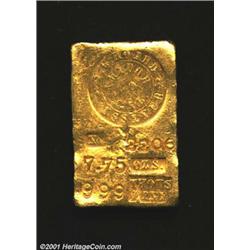
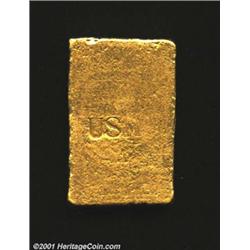
Felix Hoard was an assayer from Fiddletown in Amador County, California (slightly southeast of Sacramento, in the heart of the gold fields). The top half of the front side has Hoard’s stamp in a large circle followed by No. 2206 / 7.75 OZS. / 999 THOUS / FINE. The reverse has the letters USM. F.G. Hoard, believed born in California in the 1830s, was apparently named after Felix Grundy, Tennessee Congressman, Senator, and Attorney General under Martin Van Buren. It is unknown when Hoard learned to assay but only the transport ingots of 1880 are known today. A small group of these gold ingots were discovered in the late 1960s and the London auction house of Glendining sold many in 1969. They were later brought into the U.S. under special Treasury Department import licenses. In all, only a couple of dozen specimens are known today, far fewer than any of the ingots found on the S.S. Central America. Each ingot is stamped USM on the reverse–evidently indicating its destination for the U.S. Mint in San Francisco. This particular specimen has serial number 2206, the latest of any known examples.
[01/2002] https://www.icollector.com/1880-Felix-Grundy-Hoard-Transport-Ingot_i13954
F. G. Hoard, Assayer, Fiddletown, Amador County, California. 9.74 oz gold ingot, No 2192

Obverse Text: F.G. HOARD ASSAYER / AMADOR CO. CAL. / NO. 2192 / 9.74 OZS. / 999 THOUS FINE
This item is now at the Smithsonian.
See: https://americanhistory.si.edu/collections/nmah_741895
F. G. Hoard, Assayer, Fiddletown, Amador County, California. 9.43 oz gold ingot, No 2179
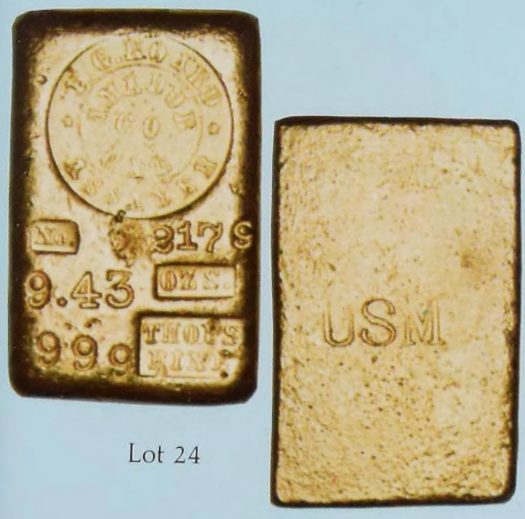
Rectangular gold ingot impressed with several prepared stamps, as illustrated, with individual numerals separately impressed to indicate the weight of 9.43 ounces, the fineness of .999, and the serial No. 2179. The edges are plain. The back is impressed with the letters USM signifying “United States Mint,” noting that the piece was accepted there. Extremely Fine or better, virtually as issued. The impressive size of the ingot, the stamps impressed from dies, and the overall appearance combines to make this one of the most appealing ingots we have seen from the Gold Rush era.
F. G. Hoard, who died on March 3, 1871, probably issued this piece circa 1869-1870. A somewhat related ingot. No. 2176, of 9.96 ounces, was offered by Superior Galleries as Lot 1719 in the 1975 American Numismatic Association sale. Bars 2177 and 2187 sold in the NASCA sale.
[03/1982] https://archive.org/details/henryhcliffordco1982bowe/page/n35/
[01/2000] https://nnp.wustl.edu/library/auctionlots?AucCoId=3&AuctionId=516740 Lot 779
[07/2003] https://archive.org/details/classicssale2003amer_201705/page/n233/
F. G. Hoard, Assayer, Fiddletown, Amador County, California. 9.08 oz gold ingot, No 2205
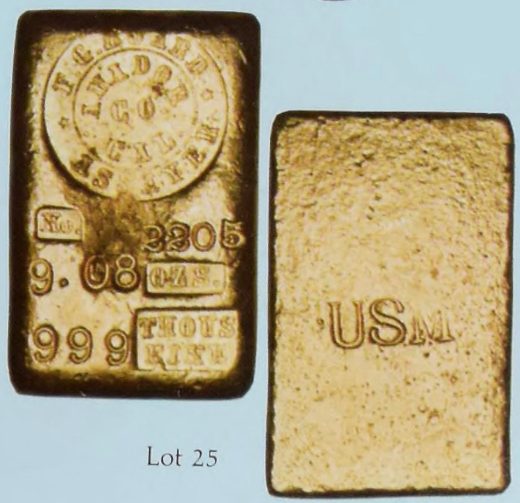
A beautiful piece similar in concept, style, and appearance to the preceding. Serial No. 2205, 9.08 ounces. Actual weight 4,364,40 grains. Made around the same time as the serial numbers seem to indicate. Extremely Fine. ($5000-6000)
Obtained from R & B (John Rowe and Mike Brownlee) Coin Co., Dallas, in 1 9b9, who got it from John Miller, California gun collector, along with the Star Mining ingot. This was the first Hoard ingot to appear on the market.
[03/1982] https://archive.org/details/henryhcliffordco1982bowe/page/n35/
Several (4) ingots originally surfaced in Glendining, January 1969, https://nnp.wustl.edu/library/auctionlots?AucCoId=512958&AuctionId=534207, as follows:
The following four bars were issued by the Amador Company with the name F G HOARD ASSAYER on them. They are undated and are more or less in their original condition.
Felix Grundy Hoard, who was the assayer of gold dust at Fiddletown in California, was born in Tennessee in 1823 and died on 3rd March, 1871. As well as being an assayer, he was also a Fiddletown Justice of the Peace. His headstone is to be seen in a graveyard in this Californian town.
F. G. HOARD ASSAYER in outer circle of stamp, AMADOR CO. CAL. in inner circle
- Bar weighing 9.43 ozs. at 999 fine, No. 2179
- Bar weighing 8.56 0zs. at 998 fine, No. 2180 (Also 5/1987 Superior Stamp)
- Bar weighing 9.85 ozs. at 999 fine, No. 2181 (Also 5/1987 Superior Stamp)
- Bar weighing 8.96 ozs. at 999 fine, No. 2182 (Also 5/1987 Superior Stamp)
No pictures were provided in the catalog. Serial number 2179 subsequently resurfaced in two subsequent auctions (above).
No. 2176 – 9.96 oz – 1975 ANA https://archive.org/details/1975anaauctionsa1975supe/page/156/
No. 2199 – 8.78 oz – [12/78] https://archive.org/details/sandspointcollec1978numi/page/n127/
9.34 oz Gold Bullion Ingot. Ca. 1870-1871. Assayer: Felix Grundy Hoard. No 2173
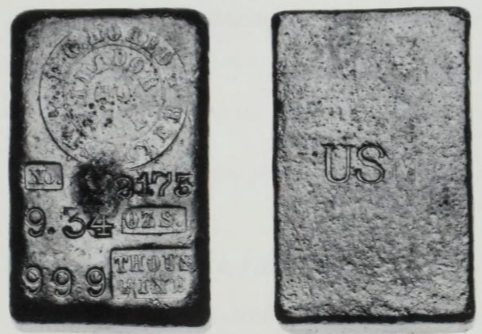
Born Ca. 1830. Died 1871. (Named after Atty. General Grundy.) Weight 9.34 ozs. Fineness .999. Number 2173. USM on the reverse denotes its destination, the San Francisco Mint. Virtually Mint State. (See Color Plate)
See Reference “Fiddletown, Amado Co, P.O., 18 miles n of Jackson . . . Hoard F.G, assayer and dealers gold dust,” pg. 138, ”The Pacific Coast Business Directory for 1867,” compiled by H. G. Langley, San Francisco, 1867.
See reference “Brokers -Stock and Money . . . Hoard F.G. Fiddletown,” pg. 608, “Classified Business Directory, California. “The Pacific Coast Business Directory for 1871 -73,” compiled by H. G. Langley, San Francisco, 1871. (Felix Grundy said to have died March 3, 1871).
[03/1983] https://archive.org/details/robisoncollectio1982stac/page/159/
8.80 Oz No Date (circa 1870-1871), Felix Grundy Hoard, Assayer, Fiddletown, Amador County, California. No. 2175
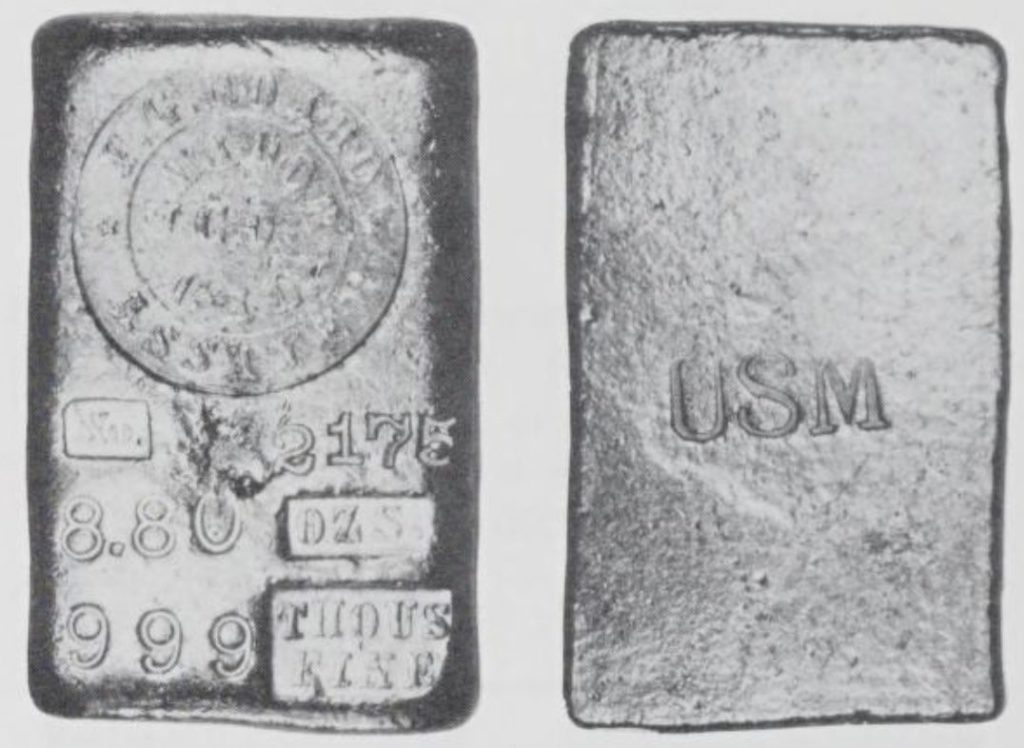
999 Thous Fine. Extremely Fine 45. All known ingots from this assayer ap¬ peared in a 1969 Glendining sale in London, and were brought to the United States under special Treasury Department import licenses. The Felix Grundy Hoard was based at Fiddletown in northern Amador County, which is slightly southeast of Sacramento in the heart of the California gold fields. The absence of a value on the ingot he stamped makes it probable that he was producing these bars directly for sale to the United States mint; this was compounded by the obvious re¬ refining of gold to pure state prior to making in¬ gots. The Grundy bars that we have seen weigh between 9 and 1 1 ounces. In fact, this is the lighest bar that has come to light. The specimen in Stack’s Lighthouse Sale of June, 1978 weighed 10.80 ozs., and the one in Rarcoa’s session of Auction ’79 weighed 10.35 ozs .
[01/1985] https://archive.org/details/drjerrybusscolle1985supe/page/238/
10.35 oz Felix Grundy Hoard Gold Ingot No 2195
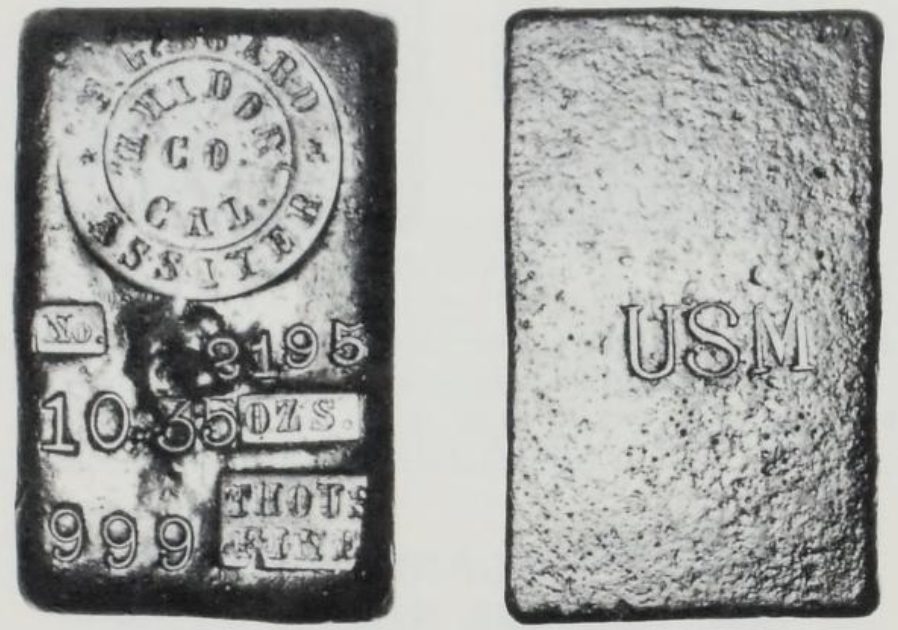
[07/1979] https://archive.org/details/auction79uniteds1979stac/page/348/
